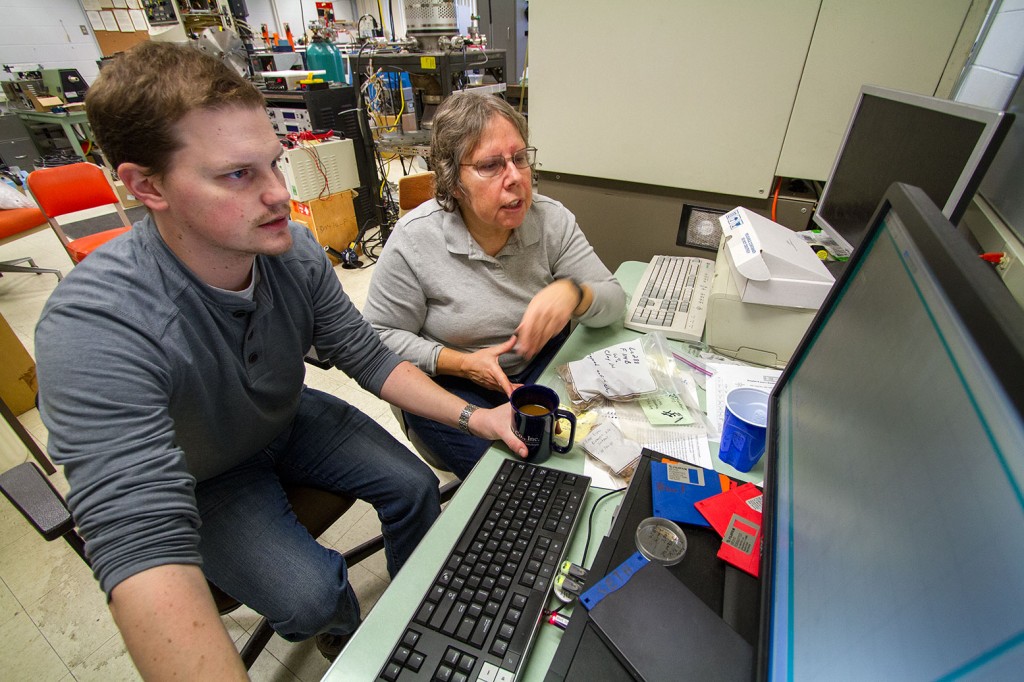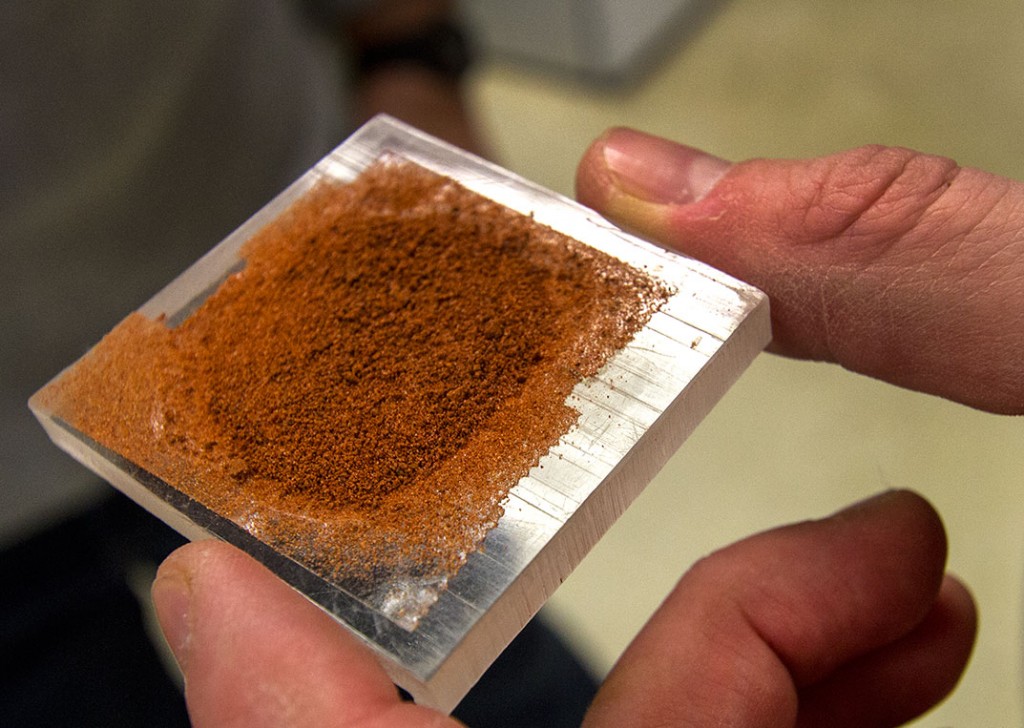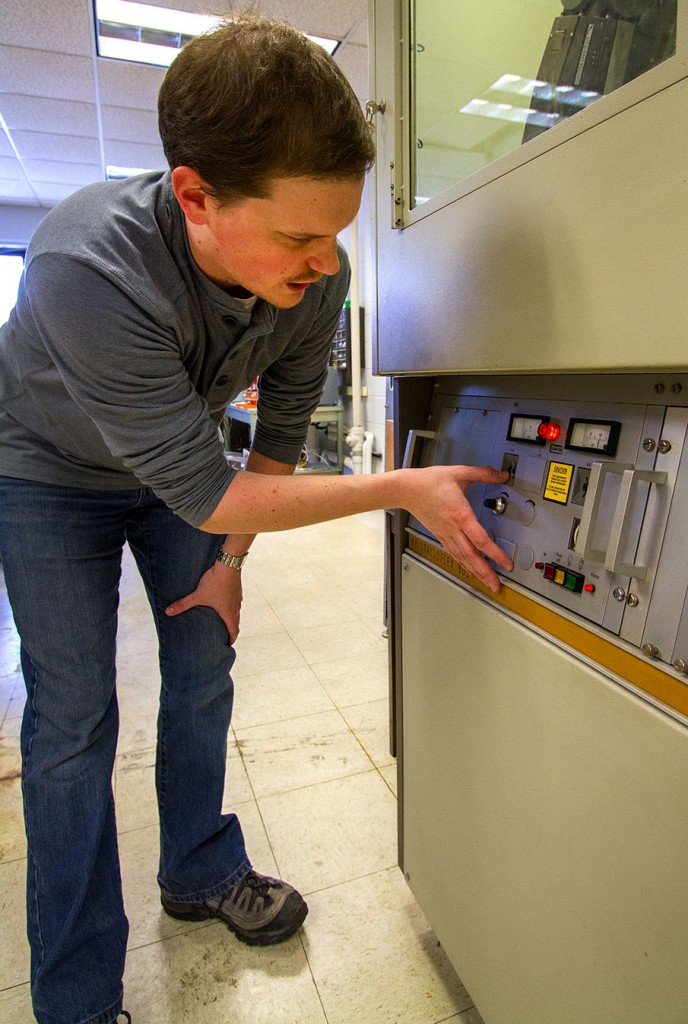Posted 8:07 p.m. Friday, March 8, 2013

Physics and Archaeology departments collaborate to identify the original source of clay used to make ancient pottery.
 [/caption]
Clay from the hills of La Crosse is unlocking clues about an ancient culture.
Archaeologists have long wondered whether people living in the La Crosse area up to 700 years ago worked cooperatively as a region. The pottery they made — and the elements and minerals within it — can tell researchers about their level of collaboration and the traditions they passed down.
In a Cowley Hall science lab, student and faculty researchers grind ancient pottery sherds uncovered from the region down to a fine powder. They use two high tech machines — an X-ray diffractometer and an X-ray fluorescence spectrometer — to measure the amount of minerals and elements inside such as quartz, calcite, lead, iron and chromium.
UW-L student researcher Terri Beal brings in clay dug from a hill near the La Crosse River, which she heats from 400 to 1600 degrees Celsius, crushes, and then compares to the powder from the ancient pots. It tells her if cultures living in the La Crosse area between 1300 and 1625 A.D. got their clay from a single source along the river and had a standard procedure for making pottery, which was shared throughout the region and over generations.
[caption id="attachment_21397" align="alignright" width="360" caption="Student and faculty researchers grind ancient pottery sherds uncovered from the region down to a fine powder. They use two high tech machines to measure the amount of minerals and elements inside."]
[/caption]
Clay from the hills of La Crosse is unlocking clues about an ancient culture.
Archaeologists have long wondered whether people living in the La Crosse area up to 700 years ago worked cooperatively as a region. The pottery they made — and the elements and minerals within it — can tell researchers about their level of collaboration and the traditions they passed down.
In a Cowley Hall science lab, student and faculty researchers grind ancient pottery sherds uncovered from the region down to a fine powder. They use two high tech machines — an X-ray diffractometer and an X-ray fluorescence spectrometer — to measure the amount of minerals and elements inside such as quartz, calcite, lead, iron and chromium.
UW-L student researcher Terri Beal brings in clay dug from a hill near the La Crosse River, which she heats from 400 to 1600 degrees Celsius, crushes, and then compares to the powder from the ancient pots. It tells her if cultures living in the La Crosse area between 1300 and 1625 A.D. got their clay from a single source along the river and had a standard procedure for making pottery, which was shared throughout the region and over generations.
[caption id="attachment_21397" align="alignright" width="360" caption="Student and faculty researchers grind ancient pottery sherds uncovered from the region down to a fine powder. They use two high tech machines to measure the amount of minerals and elements inside."] [/caption]“Getting students involved in how to use new technology to answer real questions is what we’re trying to do,” says Connie Arzigian, associate lecturer of Sociology and Archaeology.
The research started several years ago when former UW-L student Lauren Roeglin asked Seth King, assistant professor of physics, about using his equipment and expertise in material science to understand the origin of clay in pottery artifacts. She had learned from previous earth science and archaeology classes that an X-ray Diffraction System can be used to source where materials come from. As an archaeology major, she was interested in applying XRD to an archaeological research project, so she told Arzigian she wanted to develop a research project that would employ XRD for archaeological applications.
“This research allows me to combine my interests in the fields of archaeology and earth sciences and I am able to work between different departments and with people who come at this research from different research aspects,” says Roeglin, who continues the research today as a geology major at UW-Eau Claire.
The research continues at UW-L with help from Beal. They've expanded to investigate the temperature at which the ancient pots were fired. If temperatures were above the average campfire, the cultures would have had to establish a method and design facilities to fire pots.
So far results show that the pottery is matching local clay and appears to be coming from a common source — along the La Crosse River on La Crosse’s north side. It also appears to be a consistent source over time throughout the La Crosse Terrace, which spans from south La Crosse to Holmen. In short, information was being shared across the region and passed on over time.
“Archaeologists know we need to be talking to physicists because they can help us answer some very fundamental questions,” says Arzigian.
[caption id="attachment_21408" align="alignright" width="555" caption="Assistant Professor of Physics Seth King uses high tech machines to study the elements and minerals inside ancient pottery."]
[/caption]“Getting students involved in how to use new technology to answer real questions is what we’re trying to do,” says Connie Arzigian, associate lecturer of Sociology and Archaeology.
The research started several years ago when former UW-L student Lauren Roeglin asked Seth King, assistant professor of physics, about using his equipment and expertise in material science to understand the origin of clay in pottery artifacts. She had learned from previous earth science and archaeology classes that an X-ray Diffraction System can be used to source where materials come from. As an archaeology major, she was interested in applying XRD to an archaeological research project, so she told Arzigian she wanted to develop a research project that would employ XRD for archaeological applications.
“This research allows me to combine my interests in the fields of archaeology and earth sciences and I am able to work between different departments and with people who come at this research from different research aspects,” says Roeglin, who continues the research today as a geology major at UW-Eau Claire.
The research continues at UW-L with help from Beal. They've expanded to investigate the temperature at which the ancient pots were fired. If temperatures were above the average campfire, the cultures would have had to establish a method and design facilities to fire pots.
So far results show that the pottery is matching local clay and appears to be coming from a common source — along the La Crosse River on La Crosse’s north side. It also appears to be a consistent source over time throughout the La Crosse Terrace, which spans from south La Crosse to Holmen. In short, information was being shared across the region and passed on over time.
“Archaeologists know we need to be talking to physicists because they can help us answer some very fundamental questions,” says Arzigian.
[caption id="attachment_21408" align="alignright" width="555" caption="Assistant Professor of Physics Seth King uses high tech machines to study the elements and minerals inside ancient pottery."] [/caption]
King says an additional benefit of inter-departmental collaboration is eliminating the inherent bias of researchers who are familiar with the origins of their material they are studying. Both King and Arzigian regularly collaborate with other departments when conducting research.
As the research continues, they’ll look at sherds of pottery from ancient settlers who lived along the Root River in Minnesota to see if they used the same as clay as La Crosse settlers — supporting the hypothesis that the cultures migrated west to southeast Minnesota after La Crosse.
[/caption]
King says an additional benefit of inter-departmental collaboration is eliminating the inherent bias of researchers who are familiar with the origins of their material they are studying. Both King and Arzigian regularly collaborate with other departments when conducting research.
As the research continues, they’ll look at sherds of pottery from ancient settlers who lived along the Root River in Minnesota to see if they used the same as clay as La Crosse settlers — supporting the hypothesis that the cultures migrated west to southeast Minnesota after La Crosse.
